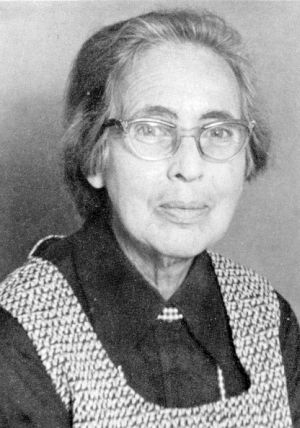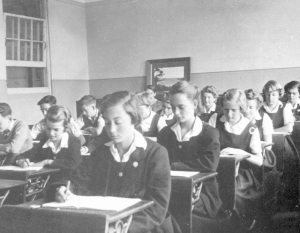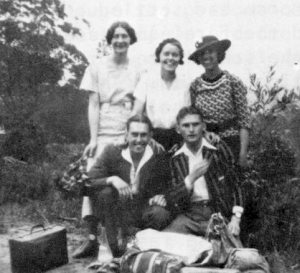Phyl Bennett Looks Back – The Early Years
This is essentially a personal reminiscence, but one endeavouring to give an all over picture of Gosford High School during its early years. My own period of service here dated from early in 1935 until the end of 1959 so for the first eight years of that time I worked under the High School’s first principal, Herbert Stoyles, who had been appointed to open the newly built High School in 1929.
Actually, it was not quite ready for occupation on time, so the first pupils spent another fortnight at the old site in Georgina Terrace where the Rural School had operated under Mr Macartney. There, classes for those not taking the new courses remained until they left school at fourteen. The high school children fell into groups: one, General Studies, which alone led on to Matriculation (English, Latin, French, two Mathematics, Science, History, Geography) and the other a Commercial Course (English, French, one Maths, History, Geog¬raphy, Business Principles, Typing and Shorthand).
By the time I arrived, Departmental Policy had been altered and all secondary pupils became part of Gosford High School though the Agriculture, Woodwork and Metalwork classes were still held in the old rooms on the hill. As these were vacated, the primary school, of which Mr George Walpole was Headmaster, expanded into the weatherboard classrooms perched on the rocky hillside, each pair reached by a perilous flight of splintery steps leading on to a long narrow verandah.
The new building in Etna Street had reached bursting point by 1935. The staff of 35 were crowded into two little rooms at the head of each set of stairs, the whole of the top floor was enclosed as classrooms, the open space downstairs between the Headmaster’s office and the western stairs, had classes behind temporary partitions. I remember English in a 2D class of boys just where Len Walpole now has his office. Upstairs in the centre room was the beginnings of the Library, below (the vestibule now), was merely another classroom.
The numbers of children were rapidly increasing as the depression was pushing stricken families into the numerous holiday cottages in the area and local citizens, proud of the increasing successes of the first batches of Leaving Certificate candidates, were sending their children to their own school instead of to expensive boarding schools.
Remember Gosford High School served a district which stretched from Brooklyn to Awaba, from Wiseman’s Ferry to the coast. Children simply poured on to the railway station about twenty to nine and crowded it again at four in the afternoon. Many of them had bus, bike or sulky rides to and from their home stations as well, and many walked, or were picked up by neighbours. The country buses from the Mountain, The Entrance, Terrigal and Davistown were ramshackle friendly affairs. There were few children in the town who didn’t walk to school, though some were set down by car and very few teachers drove to school.
The teachers themselves were all young or youngish graduates if they taught the academic subjects but the specialist teachers (on a lower rate of pay:) were mostly holders of diplomas from Hawkesbury Agricultural College or Technical College. It was out of consideration for them that the others gave up wearing their university gowns, but these were worn for the formal Speech Days and presentation of prizes for many years. Needless to say, science teachers discarded them early in favour of long grey coats while up in the labs.
There was no special sports staff in those days, but there was no shortage of coaches for hockey (my specialty for many years) or for football or cricket, always strong in the district. One football coach was Bill Crisp, later Principal of the Technical College in the old Darlinghurst Gaol buildings. Private tennis courts were as common then as swimming pools are today, so many players scattered out through the town to where these were lent to us. Swimming was in a racketty fenced area in the bay where the Olumpic Pool now is, with rotting palings held together by rusting mesh. We taught hundreds to swim there, but never failed to sigh with relief when the last one was accounted for. Anxiety made the staff sharp with any offenders who were slow to have their names marked off before they dressed. We’d never have found them in the murk if there had been delay, and never in all those years did we lose one.
The annual sports days were town events, beginning with a march from school to the baths, or to Waterside Park, as it was then, for athletics. Not many of the records set then still stand; tracks were rough and hastily prepared, but the contests were fierce and the contestants eager.
Proud citizens had formed the P & C Association even before the new school opened and the houses” were in full operation when I joined the staff. The presiding personality of the Association was Mrs Wheeler who became patron of one house. Members of that family are still part of this community. The proprietor of the Union Hotel, a quietly spoken man who had a daughter at the school, sponsored Rowe House; Mr Kingsbury, editor of the old Gosford Times sponsored another, and the then recently formed Old Students’ Union (its president was Mrs Wheeler’s son Roy, who was to become an M.L.A. for this area) adopted the fourth.
The depression years drew people together as well as making them suffer, but Wednesday, that joyous sports day for so many, was often sparsely attended. You see, dole day was Thursday and in homes where supplies ran short families often spent most of Wednesday in bed to feel their hunger less. Teachers heard many sad stories and quietly collected produce and goods to redistribute inconspicuously. Farmers let us pick vegetables and fruit, plentiful but unsaleable. We mended scarce textbooks, watched paper wasn’t wasted, even wrote “trial” examination papers on blackboards after school, lent our own books, borrowed from Sydney libraries and still gave honours classes in our own time. (There was no timetable allowance for them).
Winifred Moore was Supervisor of girls before me, and a finer and more socially responsible teacher would be hard to find. Her qualifications were varied. Besides her degree (she taught English History) she was a trained pianist and a remarkable swimming instructor, though never a competition swimmer. Many a desolate child and worried parent owed much to her for help and consolation.
Staff and children, we made our own fun. Recently Ken Castell, who came here as a young Woodwork teacher in 1936 and who retired from Woy Woy last year, brought out snaps taken of the staff at that time. Once a week we used to scramble to the top of President’s Hill (no lazy man’s car route then) and have a campfire and sing-song. The next year we had to be down by a certain hour as that was when Sid Broome waved his father through at the Narara railway crossing – his father drove the Tablelands Express.
We took youngsters hiking too, up to the Railway Dam, even to Somersby Falls or out to the coast to swim in unpolluted Wamberal Lake, our special swimming spot. The married couples on the staff had a different pattern of life, with young families absorbing them, but they too were becoming attached to the district and how many of them returned here: The Graltons, the Roxbys, Ted Jeffrey, Hec Egger and many more.
Mr John Gibson, Headmaster from 1943 to 1948 stayed with us long enough to make a definite impression on the school. Though offered charge of city schools that others might have envied, he preferred to remain in his lovely Point Frederick home until his retirement. Mr Gibson’s deputies were Mr Lake, a very charming man and Mr L. A. Kingston, who had formerly taught at the school. In 1948 Reg Burdon succeeded him and during the year of Mr Wotten’s Headmastership he was acting Headmaster for some months. A most popular and pleasant man he left to go to North Sydney Technical High, so Mr Thomas completed that year as acting – head.
In 1952 Graham Shaw became Headmaster and Ted Jeffrey returned as Deputy, Mr Thomas stepping back to be Maths Master. Mr Shaw, a maths man too, was a lover of classical music, a cricketer, a returned soldier from the first world war and one of the most vital personalities to enter the school. He came when better times nationwide allowed developments in education and for the first time subject masters took over duties of special organisation. It meant we had a sudden influx of men. Men only were appointed to direct subject, except for the Home Science, which had a mistress. The men teachers often had their ambitions set on a rapid promotion and a swift return to city schools, but many of them were fine teachers if not citizens of the town in the sense that teachers had been in earlier times. It meant that the children themselves felt closer to some of the old identities than to the newcomers and I noticed that these were the years when the captains were particularly independent young people, amongst them John Holden, who with Michael Cooper, were the driving force of some of the most exciting football teams ever fielded by the school. And how the staff loved them: Years after, when I went to see another University Shield game I saw a row of men huddled close together on a special seat inside the fence. Now who were they? Ted Roxby, Jack Holmes and surely Fred Haron. I leave you to add other names.
Some of the new masters, especially the returned servicemen, were however, exceptional. I mention Ken Moulton with a kind of calm fire in him after his years in Changi and an English teacher, genial, restless Rex Black, whose family became part of the school life and well loved Larry Foley (wittier even than Ted Roxby) who stayed in the district and died here.
A later arrival was Les 0′Neill, fresh from a brilliant run at Murwillumbah, and now the progressive Principal at The Entrance.
Next the War and Depression Years
The school history section of this site is from the publication Looking Back 1929 to 1979 for the 50th centenary of the school. The publication was produced by the student committee – Tony Lamb, Sue Wishart, Chris Bell, Karen Chapman, Cathy Hughes with support from then History Mistress Mrs Elizabeth Ferguson and support an photography assistance from then Headmaster Mr Peter Feilen.



